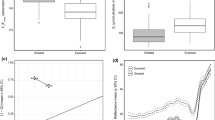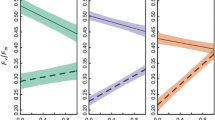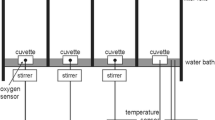Abstract
Light is often the most abundant resource within the nutrient-poor waters surrounding coral reefs. Consequently, zooxanthellae (Symbiodinium spp.) must continually photoacclimate to optimise productivity and ensure coral success. In situ coral photobiology is becoming dominated by routine assessments using state-of-the-art non-invasive bio-optical or chlorophyll a fluorescence (bio-physical) techniques. Multiple genetic types of Symbiodinium are now known to exist; however, little focus has been given as to how these types differ in terms of characteristics that are observable using these techniques. Therefore, this investigation aimed to revisit and expand upon a pivotal study by Iglesias-Prieto and Trench (1994) by comparing the photoacclimation characteristics of different Symbiodinium types based on their bio-physical (chlorophyll a fluorescence, reaction centre counts) and bio-optical (optical absorption, pigment concentrations) ‘signatures’. Signatures described here are unique to Symbiodinium type and describe phenotypic responses to set conditions, and hence are not suitable to describe taxonomic structure of in hospite Symbiodinium communities. In this study, eight Symbiodinium types from clades and sub-clades (A–B, F) were grown under two PFDs (Photon Flux Density) and examined. The photoacclimation response by Symbiodinium was highly variable between algal types for all bio-physical and for many bio-optical measurements; however, a general preference to modifying reaction centre content over effective antennae-absorption was observed. Certain bio-optically derived patterns, such as light absorption, were independent of algal type and, when considered per photosystem, were matched by reaction centre stoichiometry. Only by better understanding genotypic and phenotypic variability between Symbiodinium types can future studies account for the relative taxonomic and physiological contribution by Symbiodinium to coral acclimation.






Similar content being viewed by others
References
Apprill AM, Bidigare RR, Gates RD (2007) Visibly healthy corals exhibit variable pigment concentrations and symbiont phenotypes. Coral Reefs 26:387–397
Baker AC (2003) Flexibility and specificity in coral-algal symbiosis: diversity, ecology and biogeography of Symbiodinium. Annual Review of Ecology Evolution and Systematics 34:661–689
Behrenfeld MJ, Prasil O, Kolber ZS, Babin M, Falkowski PG (1998) Compensatory changes in Photosystem II electron turnover rates protect photosynthesis from photoinhibition. Photosynth Res 58:259–268
Berkelmans R, van Oppen MJH (2006) The role of zooxanthellae in the thermal tolerance of corals: a ‘nugget of hope’ for coral reefs in an era of climate change. Proc R Soc Lond B Biol Sci 273:2305–2312
Berner T, Dubinsky Z, Wyman K, Falkowski PG (1989) Photoadaptation and the package effect in Dunaliella-Tertiolecta (Chlorophyceae). J Phycol 25:70–78
Bidigare RR, Ondrusek ME, Morrow JH, Kiefer DA (1990) In vivo absorption properties of algal pigments. In: Spinrad RW (ed) Ocean Optics X (Proceedings Volume 1302). SPIE, Bellingham, pp 290–302
Chang SS, Prézelin BB, Trench RK (1983) Mechanisms of photoadaptation in three strains of the symbiotic dinoflagellate Symbiodinium microadriaticum. Mar Biol 76:219–229
Coffroth MA, Santos SR (2005) Genetic diversity of symbiotic dinoflagellates in the genus Symbiodinium. Protist 156:19–34
Dubinsky Z, Berman-Frank I (2001) Uncoupling primary production from population growth in photosynthesizing organisms in aquatic ecosystems. Aquat Sci 63:4–17
Dubinsky Z, Falkowski PG, Wyman K (1986) Light harvesting and utilization by phytoplankton. Plant Cell Physiol 27:1335–1349
Dubinsky Z, Stambler N, Benzion M, McCloskey LR, Muscatine L, Falkowski PG (1990) The effect of external nutrient resources on the optical-properties and photosynthetic efficiency of Stylophora-Pistillata. Proc R Soc Lond, B 239:231–246
Dustan P (1979) Distribution of zooxanthellae and photosynthetic chloroplast pigments of the reef-building coral Montastrea-Annularis Ellis and Solander in relation to depth on a West-Indian coral-reef. Bull Mar Sci 29:79–95
Enriquez S, Mendez ER, Iglesias-Prieto R (2005) Multiple scattering on coral skeletons enhances light absorption by symbiotic algae. Limnol Oceanogr 50:1025–1032
Falkowski PG, LaRoche J (1991) Acclimation to spectral irradiance in algae. J Phycol 27:8–14
Falkowski PG, Owens TG (1980) Light-shade adaptation; two strategies in marine-phytoplankton. Plant Physiol 66:592–595
Falkowski PG, Raven JA (1997) Aquatic photosynthesis. Blackwell Science, Oxford
Falkowski PG, Owens TG, Ley AC, Mauzerall DC (1981) Effects of growth irradiance levels on the ratio of reaction centers in 2 species of marine-phytoplankton. Plant Physiol 68:969–973
Falkowski PG, Jokiel PL, Kinzie RA III (1990) Irradiance and corals. In: Dubinsky Z (ed) Coral reefs ecosystems of the world. Elsevier Science Publication, Amsterdam, pp 89–107
Falkowski PG, Dubinsky Z, Muscatine L, McCloskey L (1993) Population-control in symbiotic corals. Bioscience 43:606–611
Futuyma DJ, Moreno G (1988) The evolution of ecological specialization. Annu Rev Ecol Syst 19:207–233
Garren M, Walsh SM, Caccone A, Knowlton N (2006) Patterns of association between Symbiodinium and members of the Montastraea annularis species complex on spatial scales ranging from within colonies to between geographic regions. Coral Reefs 25:503–512
Geider RJ, MacIntyre HL, Kana TM (1998) A dynamic regulatory model of phytoplanktonic acclimation to light, nutrients, and temperature. Limnol Oceanogr 43:679–694
Gorbunov MY, Kolber ZS, Lesser MP, Falkowski PG (2001) Photosynthesis and photoprotection in symbiotic corals. Limnol Oceanogr 46:75–85
Goulet TL (2006) Most corals may not change their symbionts. Mar Ecol Prog Ser 321:1–7
Harris GN, Scanlan DJ, Geider RJ (2005) Acclimation of Emiliania huxleyi (Prymnesiophyceae) to photon flux density. J Phycol 41:851–862
Hennige SJ, Smith DJ, Perkins R, Consalvey M, Paterson DM, Suggett DJ (2008) Photoacclimation, growth and distribution of massive coral species in clear and turbid waters. Mar Ecol Prog Ser 369:77–88
Hochberg EJ, Apprill AM, Atkinson MJ, Bidigare RR (2006) Bio-optical modeling of photosynthetic pigments in corals. Coral Reefs 25:99–109
Iglesias-Prieto R, Trench RK (1994) Acclimation and adaptation to irradiance in symbiotic dinoflagellates. 1. Responses of the photosynthetic unit to changes in photon flux-density. Mar Ecol Prog Ser 113:163–175
Iglesias-Prieto R, Trench RK (1997) Acclimation and adaptation to irradiance in symbiotic dinoflagellates. II. Response of chlorophyll-protein complexes to different photon-flux densities. Mar Biol 130:23–33
Iglesias-Prieto R, Govind NS, Trench RK (1991) Apoprotein composition and spectroscopic characterization of the water-soluble peridinin chlorophyll alpha-proteins from 3 symbiotic dinoflagellates. Proc R Soc Lond, B 246:275–283
Iglesias-Prieto R, Beltran VH, LaJeunesse TC, Reyes-Bonilla H, Thome PE (2004) Different algal symbionts explain the vertical distribution of dominant reef corals in the eastern Pacific. Proc R Soc Lond, B 271:1757–1763
Kaňa R, Lazar D, Prasil O, Naus J (2002) Experimental and theoretical studies on the excess capacity of photosystem II. Photosynth Res 72:271–284
Kolber Z, Zehr J, Falkowski P (1988) Effects of growth irradiance and nitrogen limitation on photosynthetic energy-conversion in photosystem-II. Plant Physiol 88:923–929
Kolber ZS, Prasil O, Falkowski PG (1998) Measurements of variable chlorophyll fluorescence using fast repetition rate techniques: defining methodology and experimental protocols. Biochim Biophys Acta Bioenerg 1367:88–106
Kolber Z, Klimov D, Ananyev G, Rascher U, Berry J, Osmond B (2005) Measuring photosynthetic parameters at a distance: laser induced fluorescence transient (LIFT) method for remote measurements of photosynthesis in terrestrial vegetation. Photosynth Res 84:121–129
Kromkamp JC, Forster RM (2003) The use of variable fluorescence measurements in aquatic ecosystems: differences between multiple and single turnover measuring protocols and suggested terminology. Eur J Phycol 38:103–112
LaJeunesse TC (2001) Investigating the biodiversity, ecology, and phylogeny of endosymbiotic dinoflagellates in the genus Symbiodinium using the ITS region: In search of a “species” level marker. J Phycol 37:866–880
LaJeunesse TC (2002) Diversity and community structure of symbiotic dinoflagellates from Caribbean coral reefs. Mar Biol 141:387–400
LaJeunesse TC, Trench RK (2000) Biogeography of two species of Symbiodinium (Freudenthal) inhabiting the intertidal sea anemone Anthopleura elegantissima (Brandt). Biol Bull 199:126–134
LaJeunesse TC, Thornhill DJ, Cox EF, Stanton FG, Fitt WK, Schmidt GW (2004a) High diversity and host specificity observed among symbiotic dinoflagellates in reef coral communities from Hawaii. Coral Reefs 23:596–603
LaJeunesse TC, Bhagooli R, Hidaka M, DeVantier L, Done T, Schmidt GW, Fitt WK, Hoegh-Guldberg O (2004b) Closely related Symbiodinium spp. differ in relative dominance in coral reef host communities across environmental, latitudinal and biogeographic gradients. Mar Ecol Prog Ser 284:147–161
Laurion I, Blouin F, Roy S (2004) Packaging of mycosporine-like amino acids in dinoflagellates. Mar Ecol Prog Ser 279:297–303
Lesser MP (2004) Experimental biology of coral reef ecosystems. J Exp Mar Biol Ecol 300:217–252
Lesser MP, Farrell JH (2004) Exposure to solar radiation increases damage to both host tissues and algal symbionts of corals during thermal stress. Coral Reefs 23:367–377
Levy O, Dubinsky Z, Achituv Y (2003) Photobehavior of stony corals: responses to light spectra and intensity. J Exp Biol 206:4041–4049
MacIntyre HL, Kana TM, Anning T, Geider RJ (2002) Photoacclimation of photosynthesis irradiance response curves and photosynthetic pigments in microalgae and cyanobacteria. J Phycol 38:17–38
Mauzerall D, Greenbaum NL (1989) The absolute size of a photosynthetic unit. Biochim Biophys Acta 974:119–140
Mazel CH (1997) Diver-operated instrument for in situ measurement of spectral fluorescence and reflectance of benthic marine organisms and substrates. Opt Eng 36:2612–2617
McDougall KE, Gibb SW, Boyd KG, Brown BE (2006) ‘Chlorophyll-like’ compounds as novel biomarkers of stress in corals. Mar Ecol Prog Ser 325:137–144
Medlin LK, Kaczmarska I (2004) Evolution of the diatoms: V. Morphological and cytological support for the major clades and a taxonomic revision. Phycologia 43:245–270
Moberg F, Folke C (1999) Ecological goods and services of coral reef ecosystems. Ecol Econ 29:215–233
Moore CM, Lucas MI, Sanders R, Davidson R (2005) Basin-scale variability of phytoplankton bio-optical characteristics in relation to bloom state and community structure in the Northeast Atlantic. Deep-Sea Res Part I 52:401–419
Moore CM, Suggett DJ, Hickman AE, Kim YN, Tweddle JF, Sharples J, Geider RJ, Holligan PM (2006) Phytoplankton photoacclimation and photoadaptation in response to environmental gradients in a shelf sea. Limnol Oceanogr 51:936–949
Munekaga Y, Hashimoto M, Miyaka C, Tomizawa KI, Endo T, Tasaka M, Shikanai T (2004) Cyclic electron flow around photosystem I is essential for photosynthesis. Nature 429:579–582
Muscatine L (ed) (1990) The role of symbiotic algae in carbon and energy flux in reef corals. Elsevier Science Publishing Company, Amsterdam
Porra RJ, Thompson WA, Kriedemann PE (1989) Determination of accurate extinction coefficients and simultaneous-equations for assaying chlorophyll-a and chlorophyll-b extracted with 4 different solvents - verification of the concentration of chlorophyll standards by atomic-absorption spectroscopy. Biochim Biophys Acta 975:384–394
Provasoli L, McLaughlin JJA, Droop MR (1957) The development of artificial media for marine algae. Arch Mikrobiol 25:392–428
Ralph PJ, Gademann R, Larkum AWD, Schreiber U (1999) In situ underwater measurements of photosynthetic activity of coral zooxanthellae and other reef-dwelling dinoflagellate endosymbionts. Mar Ecol Prog Ser 180:139–147
Reynolds JM, Bruns BU, Fitt W, Schmidt GW (2008) Enhanced photoprotection pathways in symbiotic dinoflagellates of shallow-water corals and other cnidarians. Proc Natl Acad Sci USA 105:13674–13678
Robison JD, Warner ME (2006) Differential impacts of photoacclimation and thermal stress on the photobiology of four different phylotypes of Symbiodinium (Pyrrhophyta). J Phycol 42:568–579
Rodriguez-Roman A, Iglesias-Prieto R (2005) Regulation of photochemical activity in cultured symbiotic dinoflagellates under nitrate limitation and deprivation. Mar Biol 146:1063–1073
Sampayo EM, Franceschinis L, Hoegh-Guldberg O, Dove S (2007) Niche partitioning of closely related symbiotic dinoflagellates. Mol Ecol 16:3721–3733
Savage AM, Trapido-Rosenthal H, Douglas AE (2002) On the functional significance of molecular variation in Symbiodinium, the symbiotic algae of Cnidaria: photosynthetic response to irradiance. Mar Ecol Prog Ser 244:27–37
Six C, Finkel ZV, Rodriguez F, Marie D, Partensky F, Campbell DA (2008) Contrasting photoacclimation costs in ecotypes of the marine eukaryotic picoplankter Ostreococcus. Limnol Oceanogr 53:255–265
Stambler N, Dubinsky Z (2005) Corals as light collectors: an integrating sphere approach. Coral Reefs 24:1–9
Suggett DJ, Oxborough K, Baker NR, MacIntyre HL, Kana TM, Geider RJ (2003) Fast repetition rate and pulse amplitude modulation chlorophyll a fluorescence measurements for assessment of photosynthetic electron transport in marine phytoplankton. Eur J Phycol 38:371–384
Suggett DJ, MacIntyre HL, Geider RJ (2004) Evaluation of biophysical and optical determinations of light absorption by photosystem II in phytoplankton. Limnol Oceanogr 2:316–332
Suggett DJ, Moore CM, Maranon E, Omachi C, Varela RA, Aiken J, Holligan PM (2006) Photosynthetic electron turnover in the tropical and subtropical Atlantic Ocean. Deep-Sea Res Part II 53:1573–1592
Suggett DJ, Le Floc’H E, Harris GN, Leonardos N, Geider RJ (2007) Different strategies of photoacclimation by two strains of Emiliania huxleyi (Haptophyta). J Phycol 43:1209–1222
Suggett DJ, Warner ME, Smith DJ, Davey P, Hennige SJ, Baker NR (2008) Photosynthesis and production of hydrogen peroxide by Symbiodinium (Pyrrhopyta) phylotypes with different thermal tolerances. J Phycol 44:948–956
Sukenik A, Bennett J, Falkowski P (1987) Light-saturated photosynthesis - limitation by electron-transport or carbon fixation. Biochim Biophys Acta 891:205–215
Tchernov D, Gorbunov MY, de Vargas C, Yadav SN, Milligan AJ, Haggblom M, Falkowski PG (2004) Membrane lipids of symbiotic algae are diagnostic of sensitivity to thermal bleaching in corals. Proc Natl Acad Sci USA 101:13531–13535
Ulstrup KE, van Oppen MJH (2003) Geographic and habitat partitioning of genetically distinct zooxanthellae (Symbiodinium) in Acropora corals of the Great Barrier Reef. Mol Ecol 12:3477–3484
van Oppen MJH, Mieog JC, Sánchez CA, Fabricius KE (2005) Diversity of algal endosymbionts (zooxanthellae) in octocorals: the roles of geography and host relationships. Mol Ecol 14:2403–2417
Warner ME, Berry-Lowe S (2006) Differential xanthophyll cycling and photochemical activity in symbiotic dinoflagellates in multiple locations of three species of Caribbean coral. J Exp Mar Biol Ecol 339:86–95
Warner ME, LaJeunesse TC, Robison JD, Thur RM (2006) The ecological distribution and comparative photobiology of symbiotic dinoflagellates from reef corals in Belize: Potential implications for coral bleaching. Limnol Oceanogr 51:1887–1897
Zar JH (1996) Biostatistical analysis, 3rd edn. Prentice-Hall Inc, N.J
Acknowledgements
The authors wish to thank Phil Davey and Maxim Gorbunov for technical support of the growth facilities and FIRe, respectively. This manuscript was greatly improved by comments from two anonymous reviewers and Robert van Woesik. This work was funded through a National Environmental Research Council postdoctoral fellowship to DJS, a NERC studentship to SJH, Highlands and Islands Enterprise (The Scottish Funding Council) and European Regional Development Funding to KEM, and a National Science Foundation grant (IOB 544765) to MEW.
Author information
Authors and Affiliations
Corresponding author
Additional information
Communicated by Environment Editor Prof. Rob van Woesik
Rights and permissions
About this article
Cite this article
Hennige, S.J., Suggett, D.J., Warner, M.E. et al. Photobiology of Symbiodinium revisited: bio-physical and bio-optical signatures. Coral Reefs 28, 179–195 (2009). https://doi.org/10.1007/s00338-008-0444-x
Received:
Revised:
Accepted:
Published:
Issue Date:
DOI: https://doi.org/10.1007/s00338-008-0444-x




